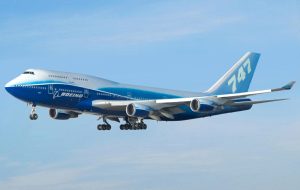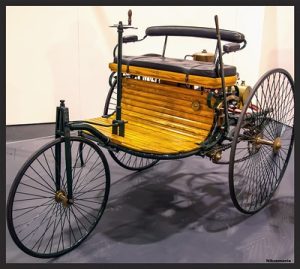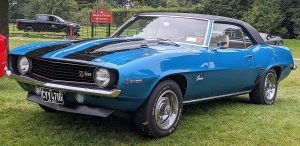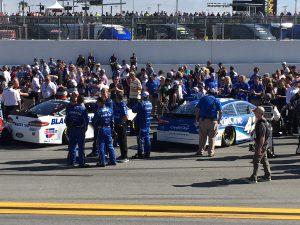12 Automobiles and Airplanes during the Baby Boomer Generation
William Wei
12.1 Introduction
Keywords
- Automobile – a usually four wheeled automotive vehicle designed for passenger transportation.
- Airplane – a powered heavier-than-air aircraft with fixed wings from which it derives most of its lift.
- Baby Boomers – a person born after World War II during the years of 1946-1964.
- Nuclear family – a family that includes two married parents of opposing genders and their biological or adoptive children living in the same residence.
- Formula racing – a motorsport road racing involving open-wheeled, single seater vehicles.
- Stock cars – an ordinary car that has been modified for racing.
Learning Objectives
By the end of this chapter, students should be able to:
- Understand how automobiles and airplanes developed during the decades of 1960s-80s.
- Describe the impact that automobiles and airplanes had on society during the decades of the 1960-80s.
- Explain how the Baby Boomers were impacted by this transportation technology.
Do you know how many parts are in a Boeing 747? Over 6 million parts, all controlled by a few pilots (Bogle, 2022)! The Baby Boomer generation, which are people born during 1946-1964 after the end of World War 2, were able to utilize airplanes and automobiles during the 1960-80s. The ability to use this transportation lets this generation create social and further technological change. In this chapter, the decades of the 1960s-1980s will be analyzed to determine how the changes in automobile and airplane technology impacted their society. Throughout the decades of the 1960-1980s, improvements in airplanes and automobiles changed the lifestyles and attitudes of the Baby Boomers.
In this chapter, we will discuss the impacts of automobiles and airplanes had on society during the 1960-1980s for the Baby Boomers. Since their early development, both technologies have gone through multiple stages of development to what we know today. So, what were automobiles and airplanes like in the 1960-80s for the Baby Boomers?
12.2 What are automobiles and airplanes?
Key Takeaways
The technology that is being discussed in this chapter is airplanes and automobiles. In this particular section, we will survey the impact these technologies had on society during the 1960-1980s for the Baby Boomer generation.
An automobile can be described as a four wheeled automotive vehicle designed for transportation. Automobiles have various uses, primarily as a way for the everyday person to travel to a destination such as the grocery store, work, or school. Automobiles are also used in the sport of racing, designed for speed and excitement. The automobile changed the Baby Boomers’ lives as it enabled them to travel further and more efficiently around their communities.
An airplane can be defined as a powered aircraft with fixed wings designed for lift. Airplanes have become very common in today’s society compared to the 1960-80s. On average, there are around 45,000 flights every day in the US alone (“Air Traffic by the Numbers”). Now that’s a lot of flights! Airplanes have many uses, including taking families on their vacations, business trips, or transporting your packages. Airplanes changed the Baby Boomers’ lives as it changed how they traveled, as air travel began to popularize during their time. Through the airplane, they could travel across the country and to other countries and become more diverse.
12.3 History of the technology
Key Takeaways
Automobiles and airplanes began to develop much quicker during the 1960-1980s and provided more societal growth. The Baby Boomers could utilize this technology to travel around their city and the country with ease.
Airplanes were initially invented in 1912 by the Wright Brothers in Kitty Hawk, North Carolina. As time progressed, different models and airplane manufacturers arose, including Boeing, founded in 1916 in Washington state. Boeing is currently one of the largest airplane developers aside from Airbus. Boeing originally began by developing simple airplanes in their 7×7 line of aircraft. They started out with the Boeing 707, eventually leading to the 737 and 747. The 757 and 767 were developed later on in the 1980s (Hayward, 2021). Since the development of their 7×7 line, airplanes began as a way to allow everyday people to travel to their destinations quicker. During the 1960-80s, airplanes became more popular, with air travel and commercial flights becoming more commonplace. The result of this popularization meant that more of the Baby Boomers could experience air travel and experience more about the world. They learned about other cultures and become more diverse.

Figure 12.1 The Boeing 747 known as the Queen of the Skies was one of the most iconic aircraft. It was nicknamed that as it was the most popular choice for long flights.
Boeing 747 by Wikimedia Commons is licensed by CC BY-SA 2.0
On the other hand, automobiles were invented in 1886 by Carl Benz. He designed the Benz patent motor wagon, which is widely considered as the first automobile (“Benz Patent Motor Car”). Since his invention, the automobile has gone through various changes and improvements. In the 1920s, automobile manufacturing was reinvented by assembly lines with Henry Ford and the Model-T. The invention of the assembly line allowed for the automobile to become more common and affordable for the public. There have been a few iconic cars, because of their popularity in the muscle car sector, during this era, such as the Ford Mustang, Chevrolet Camaro, Dodge Challenger, and Charger in the 1960s. The mass production of cars led directly to cheaper costs, allowing the Baby Boomers to afford them. As the Baby Boomers obtained cars, they could travel further and live in the American dream style suburb house. The automobile eased their ability to travel around the country, leading to more changes in their lifestyles and attitudes.

Figure 12.2 This is a model of the Benz patent motor wagon which is one of the first models of an automobile. This model of the Benz motor wagon spurred the development of modern automobiles.
Benz Patent Motor Wagon by Flickr is licensed by CC BY-NC-SA 2.0

Figure 12.3 The Chevrolet Camaro debuted in 1966 while this is a 1969 model. The Chevy Camaro is one of the most iconic American muscle cars.
1969 Chevrolet Camaro by Wikimedia Commons is licensed by CC BY-SA 4.0
Racing is another essential part of automobile development, with the main types of racecars being stock cars and formula. These racecar developments benefited from normal automobile development leading to faster, safer, and more efficient. NASCAR began in 1948 in Daytona Beach by racing stock cars (“NASCAR History”). Since the start of NASCAR, it has become more popular with the American public and was well enjoyed by the Baby Boomer generation. IndyCar and Formula racing are similar as both use formula open style cars. Formula racing began with Formula 1 and the Turin Grand Prix. Both of these racing types have become a favorite sport of many people, including the Baby Boomer generation (“Formula 1 History”).
12.4 Impact of the Technology on Society
Key Takeaways
12.4.1 Intended consequences
Airplanes and automobiles revolutionized the way society traveled as intended. They were created to ease traveling around town and the world. The automobile allowed people to visit new states and travel all around the country. During this time, the concept of the American nuclear family began to develop. The nuclear family included a heterosexual couple with children; the mother was a caretaker, and the father was the financial stabilizer. They would live in the developing suburbs and require automobiles to travel to and from. The ease of automobiles during this era of the American family aided them in traveling to work and school. (“Affects of the Automobile on Society”). Nowadays, we can travel to different states faster than in the past. During the 1960-1980s, the Interstate Highway System was already in existence, creating more accessible ways to travel by car. This system allowed automobiles to travel further and quicker.
Another way automobiles have positively impacted American society was through racing. Racing has become one of America’s favorite pastimes with NASCAR, IndyCar, and Formula 1. The development of automobiles increased society’s interest in racing as cars were faster and more exciting. Racing brought together people from all over the United States to watch these fast moving cars.

Figure 12.4 This is at the Daytona 500 which is one of NASCAR’s most famous racetracks. These pictures show the amount of people admiring the stock cars and how much racing is enjoyed by their fans.
Daytona 500 by Wikimedia Commons is licensed by CC BY-SA-2.0
Airplanes significantly impacted American society during the 1960-80s. United States residents can easily travel all around the country and the world. Thus, enriching society as more people can now travel and learn about diverse cultures and opinions. The Baby Boomers could utilize the popularization of air travel during this time period. They traveled around the country and the world and began to develop more diverse lifestyles, impacted by others.
12.4.2 Unintended consequences
While the invention of the automobile and airplanes have fully benefited society, there have been a few drawbacks. One of these drawbacks, the main consequence, is the release of Carbon gas emissions contributing to global warming. Since the increased reliance on fossil fuels by the world, carbon emissions and global warming have been an increasing problem in our modern world. The average car releases about 9000 grams of carbon dioxide per gallon. (“Greenhouse Gas Emissions”) The average plane releases about 90 kg of carbon dioxide per person per hour (“Aviation Emissions”). This unintended consequence of global warming creates a ticking clock situation as the world has to reduce the amount of carbon dioxide in the atmosphere before it is past the point of no return. This situation was not as prevalent during the time of the Baby Boomers. However, current generations are facing this issue, having to find a solution to ensure the world will still be habitable in the future.
12.5 How the tech evolved and is used today
Key Takeaways
Since the 1960-80s, automobiles have become safer, more efficient, and cheaper. New models contain new safety features like car detection and cameras every year. Airplanes have also developed into safer and more efficient aircraft used by the modern world.
Automobiles have become more efficient and more common. However, as carbon emissions have risen, automobiles have developed into electric powered vehicles that use a large battery instead of fossil fuels. Electric cars such as Tesla began to popularize in the mid 2010s as a way to reduce the carbon emissions from fossil fuels. Since then, other car brands, such as Ford and Chevrolet, have created their own version of electric vehicles. Introducing electric automobiles is a significant step to help decrease the number of carbon emissions to solve the world’s global warming problem.

Figure 12.5 The Tesla Model S is part of Tesla’s models of electric cars. Tesla has revolutionized the electric vehicle industry as it has popularized and made electric cars more affordable for the general public.
Tesla Model S by Wikimedia Commons is licensed by CC BY-SA 4.0
With racing creating a favorite pastime for American society, these cars have become faster and much safer. Multiple safety features have been developed for the average automobile and racing cars. Racing such as NASCAR, IndyCar, and Formula 1 have introduced many different forms of protection for their drivers.
NASCAR has developed multiple safety features to limit severe injury and possible death. Normal development has aided the creation of more safety features, but injuries and rough accidents sped up the development. The most recent death was in 2001 by Dale Earnhardt, spurring the mandatory use of the head and neck restraints designed to protect the driver. Since the development of these safety features, the number of injuries has drastically decreased, creating a safer racing environment for both driver and audience.
Since the development of the original Formula 1 car, cars have become much faster and more efficient. In today’s racing era, the fastest speed of a Formula 1 car is about 225 mph (Alikapala, 2022). As these cars become faster, more safety features are needed to protect these drivers. Formula 1 in 2018 developed the HALO, a metal bar that protects the driver’s head. This bar adds much-needed safety as these cars become faster, adding more risk to the drivers. Since adding all these safety features, the number of deaths in racing has drastically decreased. In 1960, 29 Formula 1 drivers were killed; in 1970, 18 Formula 1 drivers were killed. In the 2010s, only one Formula 1 driver named Jules Bianchi was involved in a fatal accident in 2014 (“Deaths in Formula 1”). There have been multiple incidents that could have ended worse without the introduction of these safety features. The most well known incident happened in Bahrain 2020 when Haas driver Romain Grosjean crashed into the safety barrier at 120 mph, creating a massive fire. Without the HALO, his crash would not have been as harmless as he only suffered minimal injuries (“Romain Grosjean Bahrain Crash”). Introducing more safety features in automobiles has drastically decreased the risk of these accidents, both in racing and in everyday use.

Figure 12.6 This McLaren Formula 1 car driven by Daniel Ricciardo features the HALO safety feature. This metal bar is one of the many safety improvements and greatly reduces the risk of serious injury or death in the case of a crash.
F1 Austria 2021 Nr. 3 Ricciardo by Wikimedia Commons is licensed by CC BY-SA 4.0
With IndyCar, they developed the aeroscreen in 2020, significantly improving driver safety. The aeroscreen is similar to the Formula 1 HALO, but it suffered a few drawbacks as it was a difficult adjustment (Martin, 2019). In the 2010s, only two drivers died from fatal accidents compared to 8 drivers in the 1960-80s (Vielhaber). The evolution of safety features protects these drivers from dangerous accidents and demonstrates how safety continues to develop in the modern world.
Compared to race cars, everyday cars now possess some similar safety features with improved crash safety, blind spot sensors, and cameras. Introducing these safety features has decreased the number of fatalities and incidents. Many new features have become mandatory in these new cars to provide more safety, such as backup cameras. Airbags and seatbelts have developed to become safer in cases of accidents. Seatbelts used to be recommended, but it is now mandatory to be worn. Since the 1960-80s, the development of safety features has greatly decreased severe injury and death of automobile passengers (“Newer Cars are Safer Cars”). This evolution of standard car features allows for more safety compared to the cars that the Baby Boomers drove.
Since the development of the earlier planes in the 7×7 lineup, Boeing has continued to develop this line with the release of the 777 in the mid 90s and the 787 in 2009. The 787 Dreamliner has spurred a new era of aviation known for its increased efficiency, comfort, and increased technology. The release of these two airplanes has changed precedent as superjumbo jets like the Airbus A380 and Boeing 747 have been slowly retired. The era of smaller twin engines with more point-to-point flying rose to prominence, compared to the idea in mind for the long haul flights with the large jumbo jets (Singh, 2020).
During the 1970s, air travel drastically changed with the introduction of the Boeing 747. It was one of the first airplanes to have two aisles compared to one aisle, like the 737, expanding the number of seats in a row. It became known as an air bus as it could hold more people than previous planes. New engines were also developed for these new planes in order to fly these long distances and carry all these people. Since the 1960s, it has been estimated that flights currently take longer due to saving money on fuel. The price of fossil fuels has dramatically increased since the 1970s as the world’s supply slowly decreases (Thornhill, 2018). This is one of the many differences between air travel in the 1960-80s and currently.
Airplanes have significantly increased safety in the design and construction of aircraft. Since 9/11, TSA was created and cracked down on security. With the increased security and design of airplanes, air travel has become one of the safest ways of transportation in the modern world. (Finley, 2022).

Figure 12.7 The Boeing 787 Dreamliner is one of the newest aircraft introduced by Boeing. It prides itself on its increased efficiency, comfort, and one of the fastest commercial aircraft.
Boeing 787 by Wikimedia Commons is licensed by CC-BY 2.0
Case Study
In this case study, this question posed on Quora asked, “How was flying experience different in the 1970s compared to now?” An answer by the user G. Badgett described his experience with air travel in the 1970s compared to today. He had multiple points to which he compared modern air travel. Badgett described it as more relaxed, fun, and more characteristic. He described how the captain once greeted passengers in a railroad hat and train whistle on a flight. These captains sometimes would be more fun and do some unprofessional but not unsafe. Badgett described how one time the captains would shut off the engines and compete to see who could coast to the gate. Badgett also described how different passengers behaved back then, with them being less demanding and better dressed (“How was flying experience different in the 70s from now?”).
Since the 1970s, air travel has become more stressful and intense. In current modern day air travel, delays and other problems can create issues with travel plans. The passengers are more demanding, with frequent videos being taken of people acting very entitled. This change in the behavior of passengers has drastically changed since the time of the Baby Boomer generation.
Chapter Summary
Automobiles and airplanes had a major impact on society in the 1960-1980s. During these decades, the Baby Boomers could utilize this technology to improve their quality of value of life. Airplanes enabled them to travel more around the country and the world while automobiles were being developed for racing and convenient general public transportation. This transportation technology considerably changed the lifestyle of the Baby Boomer generation.
Exercises
Review Questions
1.What are some intended consequences of automobiles and airplanes
-
- Carbon gas emissions
- Global warming
- Ease of traveling around the country
- Depleting the supply of fossil fuels
2. What are some unintended consequences of automobiles and airplanes?
-
- Racing as a sport
- Carbon gas emissions
- Ease of traveling around the country
- Ability to travel another country
3. How did the popularization of air travel change American society for the Baby Boomers?
-
- It allowed for them to travel around the country and world
- It allowed them to learn more about different culture
- It created new and diverse opinions on various social issues
- All of the above
Answers
- 3.
- 2.
- 4.
Food for Thought
- Compare your knowledge of modern automobiles and airplanes after thinking about what you learned in this chapter.
- Compare what you learned in this chapter about Baby Boomers and their interactions with transportation during the 1960-80s to current day interactions with transportation.
References
1970’s-1990’s. Evolution Of Cars. (n.d.). Retrieved November 7, 2022, from https://evolutionofthecar.weebly.com/1970s-1990s.html
About. Tesla. (n.d.). Retrieved November 16, 2022, from https://www.tesla.com/about
Air traffic by the numbers. Air Traffic By The Numbers | Federal Aviation Administration. (n.d.). Retrieved November 27, 2022, from https://www.faa.gov/air_traffic/by_the_numbers
Alikpala, G. (2022, May 28). Indy 500 vs formula 1 VS NASCAR: Which car is faster? Diario AS. Retrieved November 27, 2022, from https://en.as.com/racing/indy-500-vs-formula-1-vs-nascar-which-car-is-faster-n/
Applebury, G. (2021, August 10). Definition of a nuclear family: Understanding the characteristics. LoveToKnow. Retrieved November 27, 2022, from https://family.lovetoknow.com/definition-nuclear-family
Austin, P. (2022, February 4). 1960s era transport developments timeline. The 1960s Project. Retrieved November 16, 2022, from https://www.the1960sproject.com/markets/companies/1960s-era-transport-developments-timeline-ocean/
Aviation Emissions . Carbon Independent. (n.d.). Retrieved November 27, 2022, from https://www.carbonindependent.org/22.html
AxleAddict. (2011, March 4). The automobile’s effects on American and world society. AxleAddict. Retrieved November 27, 2022, from https://axleaddict.com/auto-industry/Affects-of-the-Automobile-on-Society-and-Changes-Made-by-Generation
Benz Patent Motor Car: The first automobile (1885–1886): Mercedes-Benz Group. Mercedes. (n.d.). Retrieved November 16, 2022, from https://group.mercedes-benz.com/company/tradition/company-history/1885-1886.html#:~
Boeing in Brief. Boeing. (n.d.). Retrieved November 16, 2022, from https://www.boeing.com/company/general-info/index.page#/overview
Bogle, J. (2022, September 26). 50 airplane trivia facts you won’t believe you never knew. Reader’s Digest. Retrieved November 16, 2022, from https://www.rd.com/list/airplane-trivia/
Deaths in formula one. ESPN UK. (n.d.). Retrieved November 27, 2022, from http://en.espn.co.uk/f1/motorsport/story/3838.html
Environmental Protection Agency. (n.d.). Greenhouse Gas Emissions from a Typical Passenger Vehicle. EPA. Retrieved November 27, 2022, from https://www.epa.gov/greenvehicles/greenhouse-gas-emissions-typical-passenger-vehicle
The evolution of American Family Structure. CSP Online. (2022, August 5). Retrieved November 7, 2022, from https://online.csp.edu/resources/article/the-evolution-of-american-family-structure/
The evolution of the Commercial Flying Experience. Homepage. (n.d.). Retrieved November 7, 2022, from https://airandspace.si.edu/explore/stories/evolution-commercial-flying-experience
Finlay, M. (2022, October 1). How has aviation safety improved over the years? Simple Flying. Retrieved November 27, 2022, from https://simpleflying.com/how-has-aviation-safety-improved-over-the-years/
Formula 1 history. rookieroad.com. (n.d.). Retrieved November 27, 2022, from https://www.rookieroad.com/formula-1/history/
Gannett Satellite Information Network. (2016, February 14). Was air travel in the 1970s really as Groovy (and boozy) as we remember? USA Today. Retrieved November 27, 2022, from https://www.usatoday.com/story/travel/roadwarriorvoices/2016/02/14/was-air-travel-in-the-1970s-really-as-groovy-and-boozy-as-we-remember/83199262/
Hayward, J. (2021, April 5). Remember when: Boeing lined up the entire 7×7 aircraft series. Simple Flying. Retrieved November 27, 2022, from https://simpleflying.com/boeing-7×7-series-line-up/
How air travel has changed in every decade from the 1920s to today. loveexploring.com. (n.d.). Retrieved November 7, 2022, from https://www.loveexploring.com/gallerylist/86315/how-air-travel-has-changed-in-every-decade-from-the-1920s-to-today
How was flying experience different in the 70’s from now? – quora. Quora. (n.d.). Retrieved November 25, 2022, from https://www.quora.com/How-was-flying-experience-different-in-the-70s-from-now
Kirby, G. (2013, August 19). American racing in the 1960s. Motor Sport Magazine. Retrieved November 16, 2022, from https://www.motorsportmagazine.com/articles/us-scene/indycar/american-racing-1960s
Martin, B. (2019, October 9). A closer look at INDYCAR’s Aeroscreen – MotorSportsTalk: NBC Sports. MotorSportsTalk | NBC Sports. Retrieved November 27, 2022, from https://motorsports.nbcsports.com/2019/10/07/a-closer-look-at-indycars-aeroscreen/
Merriam-Webster. (n.d.). Airplane Definition & meaning. Merriam-Webster. Retrieved November 24, 2022, from https://www.merriam-webster.com/dictionary/airplane
Merriam-Webster. (n.d.). Automobile definition & meaning. Merriam-Webster. Retrieved November 24, 2022, from https://www.merriam-webster.com/dictionary/automobile
Miller, R. (2020, December 15). Miller: The 1970s – a decade in headlines. RACER. Retrieved November 27, 2022, from https://racer.com/2020/12/14/miller-the-1970s-a-decade-of-headlines/
NASCAR history. Official Site Of NASCAR. (2019, July 21). Retrieved November 27, 2022, from https://www.nascar.com/nascar-history
Newer cars are safer cars. NHTSA. (n.d.). Retrieved November 27, 2022, from https://www.nhtsa.gov/newer-cars-are-safer-cars
Novak, M. (2014, January 30). People movers: The great transportation promise of the 1970s. Gizmodo. Retrieved November 16, 2022, from https://gizmodo.com/people-movers-the-great-transportation-promise-of-the-1510958909
Romain Grosjean Bahrain crash report released with details of impact, fire. MotorSportsTalk | NBC Sports. (2021, March 6). Retrieved November 27, 2022, from https://motorsports.nbcsports.com/2021/03/06/romain-grosjean-crash-report-f1-bahrain/
Singh, S. (2020, March 26). The 1970s – when widebody aircraft became all the rage. Simple Flying. Retrieved November 27, 2022, from https://simpleflying.com/1970s-widebody-aircraft/
Thornhill, T. (2018, May 11). Flights are taking longer now than they did in the 1970s. Daily Mail Online. Retrieved November 27, 2022, from https://www.dailymail.co.uk/travel/travel_news/article-5714245/Flights-taking-LONGER-did-1970s.html
Vielhaber, D. (n.d.). Indy Car Fatalities. IndyCar drivers who died racing. Retrieved November 27, 2022, from http://indymotorspeedway.com/memorial_other.html
What is formula racing in motorsports? definition & meaning. SportsLingo. (2021, November 3). Retrieved November 27, 2022, from https://www.sportslingo.com/sports-glossary/f/formula-racing/

